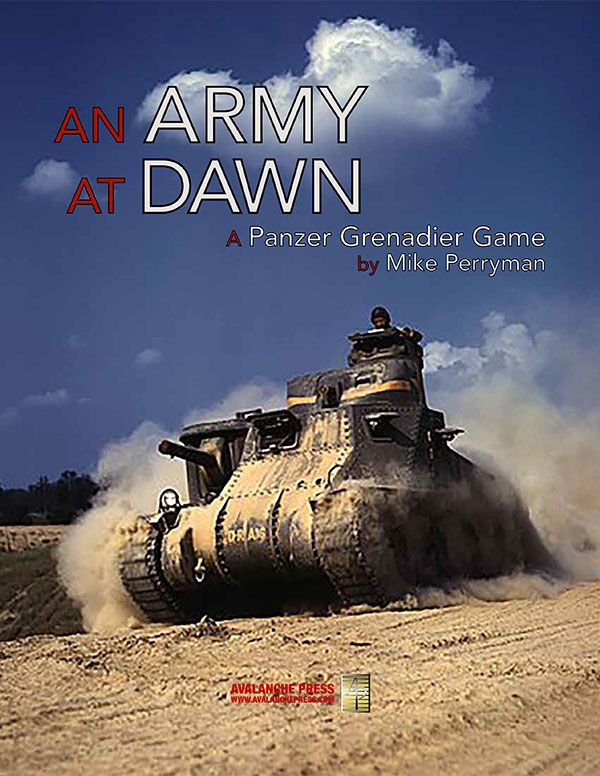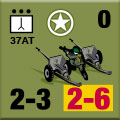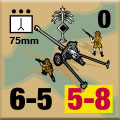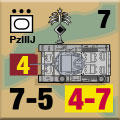| An Army at Dawn
Scenario Preview, Part Four
By Mike Bennighof, Ph.D.
June 2024
 Panzer Grenadier: An Army at Dawnlets us bring the early-war U.S. Army into action. The Sherman tank with a 75mm gun is the best they’ve got, while the Germans are showing off early samples of the Tiger tank. The main battle tank is still the M3 Lee, a decidedly second-rate affair when compared to the German Panzer IV with a long-barreled 75mm gun. Mobile anti-tank defense meant aged French-designed 75mm field gun on half-tracks. The infantry deployed 37mm anti-tank guns that had been useless in 1940 – a lifetime ago, at the pace of wartime weapons development. Panzer Grenadier: An Army at Dawnlets us bring the early-war U.S. Army into action. The Sherman tank with a 75mm gun is the best they’ve got, while the Germans are showing off early samples of the Tiger tank. The main battle tank is still the M3 Lee, a decidedly second-rate affair when compared to the German Panzer IV with a long-barreled 75mm gun. Mobile anti-tank defense meant aged French-designed 75mm field gun on half-tracks. The infantry deployed 37mm anti-tank guns that had been useless in 1940 – a lifetime ago, at the pace of wartime weapons development.
“You go to war with the army you have, not the army you might want or wish to have at a later date.” A spiritual descendant of Lloyd Fredendall said that decades later, and it’s a pathetic justification in either situation. The U.S. Army had plenty of opportunities to observe modern war; American tankers even fought at Alamein (well, one platoon’s worth). There was no excuse for some of the weaponry fielded by the Americans in Tunisia, but at least they had a lot of it.
So let’s have a look at the fifth chapter’s scenario set:
Chapter Five
Ousseltia Valley
 Located about 100 kilometers due west of Tunis, just within the border of Tunisia with Algeria, the Ousseltia Valley is part of Tunisia’s rainiest region, making it a center of agriculture for the entire nation. That’s also why it hosted the main water reservoirs for Tunisia’s major cities, Tunis and Bizerte (and continues to do so). Located about 100 kilometers due west of Tunis, just within the border of Tunisia with Algeria, the Ousseltia Valley is part of Tunisia’s rainiest region, making it a center of agriculture for the entire nation. That’s also why it hosted the main water reservoirs for Tunisia’s major cities, Tunis and Bizerte (and continues to do so).
The valley lay across the route an Allied force advancing from Algeria would have to take to reach Tunis. The multi-national British First Army would have to fight its way through the valley, in the face of stiffening Axis resistance and the blithering, babbling incompetence of Lloyd Fredendall commanding II Corps, the largest American combat formation in the Tunisian campaign. At the core of the American effort would be Combat Command B of the 1st Armored Division.
Scenario Twelve
Ousseltia Valley
21 January 1943
 To improve their defensive positions the Germans launched a major operation late on 18 January aimed at controlling the four main gaps through the Eastern Dorsals, which conveniently controlled the Tunis water supply. After faking an attack against the British they wheeled to strike the ill-equipped French and broke into the Ousseltia Valley. At 1715 on the 19th, Col. Paul Robinett received orders to lead his Combat Command B into the valley to rectify the situation. The Germans controlled the valley by the time Robinett arrived at Maktar on the 20th. He lined up his artillery support, then conducted a treacherous road march, delaying his attack until the afternoon of the following day. To improve their defensive positions the Germans launched a major operation late on 18 January aimed at controlling the four main gaps through the Eastern Dorsals, which conveniently controlled the Tunis water supply. After faking an attack against the British they wheeled to strike the ill-equipped French and broke into the Ousseltia Valley. At 1715 on the 19th, Col. Paul Robinett received orders to lead his Combat Command B into the valley to rectify the situation. The Germans controlled the valley by the time Robinett arrived at Maktar on the 20th. He lined up his artillery support, then conducted a treacherous road march, delaying his attack until the afternoon of the following day.
Conclusion
Robinett’s attack showed that Combat Command B was learning from its previous mistakes. Instead of racing willy-nilly down the road into the fire of waiting enemy anti-tank guns, the tankers waited until the supporting artillery began softening up the enemy with their fire missions and air support roared inbound. Then they advanced under control and remained organized when engaged by a platoon of Tiger tanks. While they didn’t achieve all their objectives they pushed Lueder’s battle group back far enough to open up an escape route for the French fighting to the north. This new discipline led to the 501st Heavy Panzer Detachment mistaking them for British. The day did not bring laurels for CCB but they did their job well enough, and remained combat ready for the next day.
Notes
A tank battle! The Americans have a serious edge in numbers, but the Germans have far better morale and a Tiger tank. At least the Americans have finally learned about balanced tank-infantry task forces supported by artillery and air power.
Scenario Thirteen
Confusion in the Valley
22 January 1943
 Robinett had been placed under the French Algiers Division’s command for an attack in the Ousseltia Valley, but balked at his orders, insisting that he must have reinforcements and assistance from British units. The French division and corps commanders re-iterated his instructions, but Lloyd Fredendall of II Corps insisted on sticking his fingers into the mix, adding more confusion to what should have been a straightforward situation. Robinett had been placed under the French Algiers Division’s command for an attack in the Ousseltia Valley, but balked at his orders, insisting that he must have reinforcements and assistance from British units. The French division and corps commanders re-iterated his instructions, but Lloyd Fredendall of II Corps insisted on sticking his fingers into the mix, adding more confusion to what should have been a straightforward situation.
Conclusion
Just what happened in the Ousseltia Valley is hard to determine more than eight decades later. Fighting definitely took place, and most likely it involved the Germans advancing while Robinett used Fredendall’s interference as an excuse to dodge the direct orders from his French superiors to attack. According to the U.S. Official History, Fredendall sent a staff officer to “straighten out this tangle,” but if any tangle existed, it came from Fredendall’s stupefyingly idiotic method of issuing orders:
Move your command, i. e., the walking boys, pop guns, Baker's outfit and the outfit which is the reverse of Baker's outfit and the big fellows to M, which is due north of where you are now, as soon as possible. Have your boss report to the French gentleman whose name begins with J at a place which begins with D.
This was not some elaborate code, though Fredendall justified it as such; this was raging incompetence in action. The “French gentleman” would be Alphonse Juin commanding French forces in Tunisia, whose subordinates’ orders Robinett would ignore since Fredendall only said “report to” among his inane babble when First Army had clearly told both Fredendall and Juin that Combat Command B would be attached to XIX Corps and under French command. The Americans did not attack, but they did hold most of their positions after the Germans drove in their outposts.
Notes
This is a new scenario, added by Mike Perryman. The Germans and Americans begin at very close quarters, with the Germans holding the burden of attack.
Scenario Fourteen
Attack in the Valley
23 January 1943
 Despite the Fredendall-induced confusion of the previous day (abetted by Paul Robinett of Combat Command B), the American formation had stalled the German attack but failed to defeat the enemy. The French Algiers Division commander, Agathon Deligne, re-iterated his orders for Robinett attack northward at dawn and contact the British fighting at Djebel Bargou. Citing supply difficulties, Robinett delayed until mid-afternoon. Despite the Fredendall-induced confusion of the previous day (abetted by Paul Robinett of Combat Command B), the American formation had stalled the German attack but failed to defeat the enemy. The French Algiers Division commander, Agathon Deligne, re-iterated his orders for Robinett attack northward at dawn and contact the British fighting at Djebel Bargou. Citing supply difficulties, Robinett delayed until mid-afternoon.
Conclusion
The attack stalled against determined German resistance. That evening, XIX Corps ordered Combat Command B to continue the attack come morning, while the American II Corps told Combat Command B to pull back to Ousseltia until the British and French drove the enemy from the hills. Robinett elected to pull back, leaving his allies to their own devices.
Notes
This is going to be tough for the Americans, on the attack with lower morale and only a small edge in numbers and no airplanes. Both sides field balanced tank-infantry forces, and on the limited battlefield area this is going to be a tense fight.
Scenario Fifteen
Clearing the Valley
25 January 1943
 Rather than allow Orlando Ward to commit his 1st Armored Division as a complete unit, II Corps’ Lloyd Fredendall attached the 26th Regimental Combat Team from the 1st Infantry Division to Combat Command B to form an ad hoc force under the corps headquarters’ direct control. Fredendall then ordered the force to clear the Ousseltia Valley and open the Kairouan Pass. Rather than allow Orlando Ward to commit his 1st Armored Division as a complete unit, II Corps’ Lloyd Fredendall attached the 26th Regimental Combat Team from the 1st Infantry Division to Combat Command B to form an ad hoc force under the corps headquarters’ direct control. Fredendall then ordered the force to clear the Ousseltia Valley and open the Kairouan Pass.
Conclusion
The Americans caught a break. The experienced Battle Group Weber withdrew during the previous night, leaving the defense to a recently-arrived Italian battalion. Around midday the Americans collided with the defenders, prevailing with relatively few casualties on either side.
Notes
Americans against Italians, and guess who’s the better-organized, better-led side? The Superga Division hasn’t seen combat since the brief campaign against France in 1940, but has spent the intervening years training for the abortive assault on Malta and is a match for the U.S. Army’s Big Red One and Old Ironsides. The Americans have numbers on their side and a slight edge in artillery, but they have very tough victory conditions to meet to win this one.
And that’s it for Chapter Five. Next time, we dive into Chapter Six.
You can order An Army at Dawn right here.
Big Red Package
An Army at Dawn
Big Red One
Retail Price: $92.98
Package Price: $85
Gold Club Price: $68
You can order the Big Red Package right here.
Sign up for our newsletter right here. Your info will never be sold or transferred; we'll just use it to update you on new games and new offers.
Mike Bennighof is president of Avalanche Press and holds a doctorate in history from Emory University. A Fulbright Scholar and NASA Journalist in Space finalist, he has published a great many books, games and articles on historical subjects; people are saying that some of them are actually good.
He lives in Birmingham, Alabama with his wife, three children, and new puppy. He misses his lizard-hunting Iron Dog, Leopold.
Want to keep Daily Content free of third-party ads? You can send us some love (and cash) through this link right here.
|
